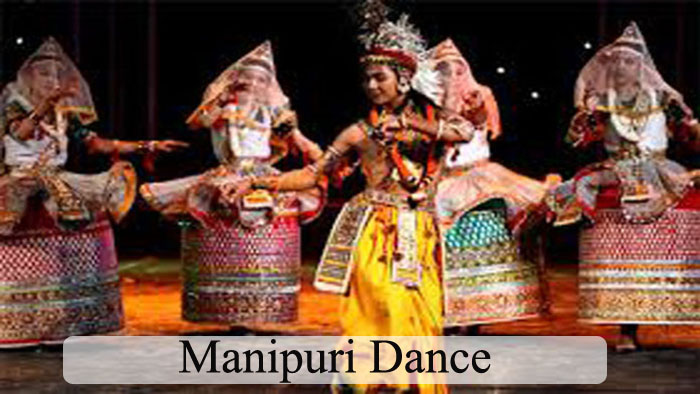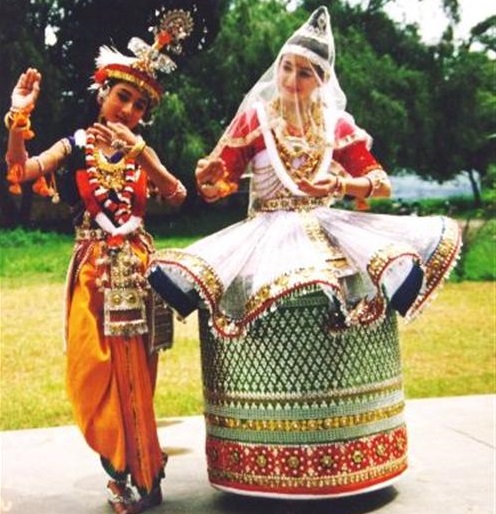Manipuri Dance – Love Inspired Dance Drama

In Manipur, dance is not just a form of art, but a way of life. Dance is a medium of expression, which is so closely interwoven with the social fabric of society that it is impossible to study one without the other. Manipuri dance is believed to be the creation of Gods. The love of Lord Krishna and Radha is the dominant theme of this dance.
Origin
In Manipuri, texts date back before 33 A.D., the legend goes that when the Supreme God, Lai Guru Sidaba, created the earth, He created seven Laibangthous (Gods) and seven Lainuras (Goddesses) and these celestial beings leveled the uneven surfaces of the earth with their celestial dance. The Classical Manipuri dance form has developed and derived from the two most popular movement traditions of Manipur, Valshnavite Natasankritan by male dancers and Rasalila by female dancers.
Dance is considered by the Manipuris as a form of worship, because of which dance holds an extremely revered, sacrosanct status in Manipuri culture. According to the traditional legend, the indigenous people of the Manipur valley were the dance experts revered as Gandharvas in the Hindu epics (Ramayana and Mahabharata), suggesting a dance tradition has existed in Manipur since antiquity.
The Manipuri dance is a team performance, with its own unique costumes, aesthetics, conventions, and repertoire. The Manipuri dance drama is, for the most part, marked by a performance that is graceful, fluid, sinuous with greater emphasis on hand and upper body gestures. It is accompanied by devotional music created with many instruments, with the beat set by cymbals (kartal or manjira) and double-headed drum (pung or Manipuri mrdanga) of sankirtan.
Three main branches of Manipuri Dance
The Lai Haraoba
Lai Haraoba means a festival of Gods. Lai Haraoba dance likely has ancient roots and shares many similarities with the dance postures of Nataraja and his legendary disciple called Tandu (locally called Tangkhu). The dance is also performed to themes related to Shaivism, Shaktism, and regional deities such as Umang Lai in Lai Haraoba.
The Sankirtana
It is a form of performing art involving ritual singing, drumming, and dancing performed in temples and domestic spaces. Through the performances which exhibit unparalleled religious devotion and energy, the performers narrate the many stories of Krishna often moving the spectators to tears.
The Ras Lila
The Ras Lila is the most important dance form in the Manipuri style. The theme revolves around the love of Krishna and the milkmaids (gopinis). The cult of Radha and Krishna, particularly the raslila, is central to its themes but the dances, unusually, incorporate the characteristic symbols (kartal or manjira) and double-headed drum (pung or Manipuri mrdanga) of sankirtan into the visual performance.

Costume
The women characters are dressed like Manipuri brides. They wear a Kumil which is an elaborately decorated barrel-shaped long skirt stiffened at the bottom and close to the top. The decorations on the barrel include gold and silver embroidery, small pieces of mirrors, and border prints of lotus, Kwaklei orchid, and other items in nature.
The Kumil is bordered at the top with an undulating gauzy translucent top skirt shaped like an open flower and tied in Trikasta or three places around the waist (front, back, and one side) with spiritual symbolism of the ancient Hindu texts.
The upper body is dressed in a velvet blouse, the head covered in a white translucent veil, to symbolically mark elusiveness. The dancers do not wear bells on the ankles as in other classical Indian dances, but like them, Manipuri dance artists do adorn the face, neck, waist, hands, and legs with round jewelry ornaments or flower garlands that flow with the dress’s symmetry.
While the male characters wear dhoti, Kurta, and headgear (Luhup). The Krishna character wears a peacock feather containing crown, with a feathery attachment at the back.
Suggested Read: Manipur – Culture and Tradition






